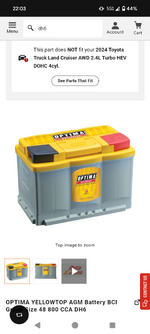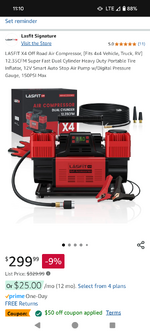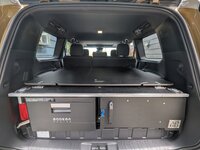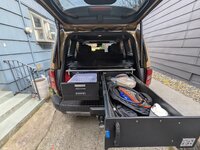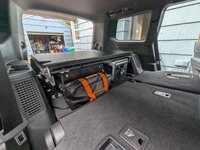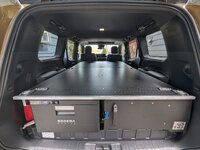The largest capacity lithium battery in H6 / AN3 size is the 60ah. I don’t think the tray can fit the H7 battery which has a max 80ah capacity. Like I stated earlier the 60ah in the lithium has the same energy density as a 120ah in a lead acid or agm battery.Thanks for the info. Do you have an idea of the largest battery that can fit in the compartment? Any larger than the 60ah?
Navigation
Install the app
How to install the app on iOS
Follow along with the video below to see how to install our site as a web app on your home screen.
Note: This feature may not be available in some browsers.
More options
You are using an out of date browser. It may not display this or other websites correctly.
You should upgrade or use an alternative browser.
You should upgrade or use an alternative browser.
Deep cycle agm battery replacement?
- Thread starter phantasticphil
- Start date
- Moderator
- #22
Update to my earlier posts......... I have installed a solar charger under the OEM roof rack and it seems to be able to take up the slack for the parasitic draw. No flat battery after having the doors open all day......LOL
How did you run the wiring and what setup did you go with?Update to my earlier posts......... I have installed a solar charger under the OEM roof rack and it seems to be able to take up the slack for the parasitic draw. No flat battery after having the doors open all day......LOL
- Moderator
- #24
My setup is just to keep the 12v battery topped off. This is the solar charger I used:How did you run the wiring and what setup did you go with?
I ran the wiring from the roof rack to the Dvr's side, top corner of the rear hatch opening, then into the "pass through" boot down to the 12v battery.
Not quite sure I understand this. You already have a deep cycle “hybrid battery” that is 1.87 KWH deep. Just keep the power on and your engine will only occasionally turned on. It uses your engine as second /third stage power source depending on what you use. What system is better than that?I'm wondering if anyone's considered or have upgraded/replaced the 12v battery with an agm deep cycle like the x2 power battery?
I'd like to have the ability to have power with the car off and not have to worry about charging an external power station for a fridge etc.
If the goal is to power refrig, any reputable lithium power station can support it way better than any AGM you can think of. I have a 1KWH power station in my trunk and I connect my dash cam and cooler to it. The power station can be recharged by either the 100W DC at second row, or the 2400 KW AC in your trunk.
No matter which scenario you are thinking about I couldn’t see AGM is a good fit in any of them.
Last edited:
- Thread starter
- #26
It's my setup so okay if you don't understandNot quite sure I understand this. You already have a deep cycle “hybrid battery” that is 1.87 KWH deep. Just keep the power on and your engine will only occasionally turned on. It uses your engine as second /third stage power source depending on what you use. What system is better than that?
If the goal is to power refrig, any reputable lithium power station can support it way better than any AGM you can think of. I have a 1KWH power station in my trunk and I connect my dash cam and cooler to it. The power station can be recharged by either the 100W DC at second row, or the 2400 KW AC in your trunk.
No matter which scenario you are thinking about I couldn’t see AGM is a good fit in any of them.
1) I don't want the engine to occasionally turn on. I camp dispersed and at trail heads with friends that tent camp. That would impact their experience and would generally be rude to have an engine cut on and off all night to keep a refrigerator running.
2) I would prefer to not use an external power station due to space and having to think about charging it before or during a trip. I setup my FJ to be completely hands off and would like something similar here. Only way to do that (save space and hands off) is replace the truck battery.
Is this the correct Optima battery replacement for a 2024+ LC?
And for pigtail attachment, 7.5A, 10A or 15A fuse? Maybe 15A for an air compressor?
I bought the LastFit dual air compressor
TIA
And for pigtail attachment, 7.5A, 10A or 15A fuse? Maybe 15A for an air compressor?
I bought the LastFit dual air compressor
TIA
Attachments
I'm a little confused by what you wrote. If the energy density of the 60 Ah lithium battery is the same energy density as a 120 Ah lead acid or AGM battery, then the lithium battery would be half the size of the lead acid but also have half the energy of the lead acid battery. Why would anyone want to do that? I thought the point of the thread was to get a battery in the same size with a greater amount of energy storage. In order to do that, the energy density would need to be greater, not the same. Am I missing something?The largest capacity lithium battery in H6 / AN3 size is the 60ah. I don’t think the tray can fit the H7 battery which has a max 80ah capacity. Like I stated earlier the 60ah in the lithium has the same energy density as a 120ah in a lead acid or agm battery.
What about an LiFePO4 battery?
Ok, so the LC250 uses an H6 battery size. Antigravity uses the same OEM case for easy installation and direct fitment.I'm a little confused by what you wrote. If the energy density of the 60 Ah lithium battery is the same energy density as a 120 Ah lead acid or AGM battery, then the lithium battery would be half the size of the lead acid but also have half the energy of the lead acid battery. Why would anyone want to do that? I thought the point of the thread was to get a battery in the same size with a greater amount of energy storage. In order to do that, the energy density would need to be greater, not the same. Am I missing something?
AGM and Lead acid batteries rated at 70ah would provide only 30-40% of it's rated amp hours at 12v or higher.
Lithium, however will provide 90% of its amp hour rating at 12v or higher. (see power curve below)
Basically, for less weight, you can have more usable energy available to you.
With that said it does come at a higher price point.
One of the best Lead acid H6 batteries is an Interstate MTP-48/H6-1, rated at 730cca and 70ah at a weight of 45.40 lbs. $194.99
Compared to the AGM version of the H6 Interstate 65-48/H6-AGM BATTERY, rated at 760cca and 70ah at a weight of 45.41 lbs $274.99
Antigravity Batteries Lithium H6 battery AG-H6-60-RS, rated at 1800ca and 60ah at a weight of 19.5 lbs $1049.99
- Thread starter
- #31
I ended up giving up on this path and begrudgingly went with an anker c1000 powered by the inverter (may consider something more integrated in the future). Benefit is it fitting in nicely with my ADGU drawer system.
Attachments
The graph isn't particularly useful because it doesn't specify the energy capacity of the two batteries used in comparison. If you have a 120 Ah lead acid battery producing 12 V for 40% of the discharge cycle, that makes for 48 Ah above 12 V. A 60 Ah lithium ion battery maintaining above 12 V for 90% would be 52 Ah above 12 V. That's roughly equivalent, if the graph actually is correct. I do think you are trying to make a valid point - the usefulness of a battery isn't measured strictly by its amp-hour rating. All batteries produce a lower voltage as they drain and if you are using something more sophisticated than a flashlight, then a battery could still have 40% of its charge remaining, but not have enough potential difference to accomplish anything. Some of the best testing of batteries I've seen under load is done by the Torque Test Channel. Start at about 4:00 minutes into the video if you want to see a straightforward comparison of Voltage vs. Time for the batteries. Project Farm has also done some nice testing of car batteries (with some surprising conclusions.)Ok, so the LC250 uses an H6 battery size. Antigravity uses the same OEM case for easy installation and direct fitment.
AGM and Lead acid batteries rated at 70ah would provide only 30-40% of it's rated amp hours at 12v or higher.
Lithium, however will provide 90% of its amp hour rating at 12v or higher. (see power curve below)
Basically, for less weight, you can have more usable energy available to you.
With that said it does come at a higher price point.
View attachment 30251
One of the best Lead acid H6 batteries is an Interstate MTP-48/H6-1, rated at 730cca and 70ah at a weight of 45.40 lbs. $194.99
Compared to the AGM version of the H6 Interstate 65-48/H6-AGM BATTERY, rated at 760cca and 70ah at a weight of 45.41 lbs $274.99
Antigravity Batteries Lithium H6 battery AG-H6-60-RS, rated at 1800ca and 60ah at a weight of 19.5 lbs $1049.99
- Moderator
- #33
The Optima DH6 is a direct replacement.Is this the correct Optima battery replacement for a 2024+ LC?
And for pigtail attachment, 7.5A, 10A or 15A fuse? Maybe 15A for an air compressor?
I bought the LastFit dual air compressor
TIA
The graph isn't particularly useful because it doesn't specify the energy capacity of the two batteries used in comparison. If you have a 120 Ah lead acid battery producing 12 V for 40% of the discharge cycle, that makes for 48 Ah above 12 V. A 60 Ah lithium ion battery maintaining above 12 V for 90% would be 52 Ah above 12 V. That's roughly equivalent, if the graph actually is correct. I do think you are trying to make a valid point - the usefulness of a battery isn't measured strictly by its amp-hour rating. All batteries produce a lower voltage as they drain and if you are using something more sophisticated than a flashlight, then a battery could still have 40% of its charge remaining, but not have enough potential difference to accomplish anything. Some of the best testing of batteries I've seen under load is done by the Torque Test Channel. Start at about 4:00 minutes into the video if you want to see a straightforward comparison of Voltage vs. Time for the batteries. Project Farm has also done some nice testing of car batteries (with some surprising conclusions.)
So the chart is useful in simple visual terms explaining the discharge ramp of lead acid and agm batteries vs a lithium battery.
I am not sure what point you are trying to make with your comment and video? Lithium batteries are not all created equal and the BMS in most lithium batteries as well as the cells used in the battery will play a roll in the power available. Lithium deep cycle batteries normally use a less expensive cell designed for a longer limited draw, say a continuous 100amp draw until it is empty but cant deliver a starting punch of cranking amperage. A Lithium Starting battery can deliver that cranking amperage punch for starting but also can still be used for a longer lower amp draw like running a 12v fridge proving it to be dual purpose.
The 60ah Antigravity Lithium battery in this application for use with its 12v system will run more efficiently and last longer for its capacity vs a 70ah standard battery. It will have more usable power in the same packaged size of the OEM H6 case than any other option on the market. So if folks want to have a battery that can accept a charge faster, have a larger useable reserve capacity of power to draw from, Antigravity Lithium will win everytime over the leadacid and agm when put to a capacity draw test.
They are likely great, but they are expensive, very expensive. I'd prefer to buy a decent quality jump pack TBH. Which everyone should have in their vehicle anyway. I can just see something going wrong with the electrical system in our new to the market LC's and the dealership trying to blame the LifePO4 battery... and I'm not a "but the warranty" kind of guy.What about an LiFePO4 battery?
I do keep looking at the Antigravity, I'll admit it.
Out of curiosity do the peaks in these diagrams correlate with driving periods? Like does the hybrid system keep the voltage at the battery terminals at 14ish whenever it's ON? Or is that some peculiarity of lithium batteries? Or are those just random charging periods?For full transparency I have been using/selling their batteries since 2014.
I have their lithium batteries in my Subaru BRZ’s, my Motorcycles and two in my FJ Cruiser a 60ah group 27r for starting with a RedArc BCDC charging a 120ah deepcycle house battery.
I used their battery tracker to watch and log the charging profile of my 2025 LandCruiser.
I'm saying the graph is a sales tool, not something that contains useful data comparing two real batteries. The video shows an example of how to properly compare the performance of real batteries under real conditions. And, if the energy density of two batteries is the same, then given the same volume they should store the same amount of energy. Given the lack of real data, I'm not convinced that the Antigravity battery has the substantial advantages you suggest. Having said that, I would be interested in seeing real data obtained by an independent laboratory that would compare the performance of the Antigravity battery to other automotive batteries. I certainly wouldn't spend over $1000 on the basis of the graph you presented and the claims made by the manufacturer. The one measurable advantage that is easily confirmed is a significant weight reduction compared to traditional batteries. In addition, the reserve of the Antigravity appears to solve the problem of needing a jump box.So the chart is useful in simple visual terms explaining the discharge ramp of lead acid and agm batteries vs a lithium battery.
I am not sure what point you are trying to make with your comment and video? Lithium batteries are not all created equal and the BMS in most lithium batteries as well as the cells used in the battery will play a roll in the power available. Lithium deep cycle batteries normally use a less expensive cell designed for a longer limited draw, say a continuous 100amp draw until it is empty but cant deliver a starting punch of cranking amperage. A Lithium Starting battery can deliver that cranking amperage punch for starting but also can still be used for a longer lower amp draw like running a 12v fridge proving it to be dual purpose.
The 60ah Antigravity Lithium battery in this application for use with its 12v system will run more efficiently and last longer for its capacity vs a 70ah standard battery. It will have more usable power in the same packaged size of the OEM H6 case than any other option on the market. So if folks want to have a battery that can accept a charge faster, have a larger useable reserve capacity of power to draw from, Antigravity Lithium will win everytime over the leadacid and agm when put to a capacity draw test.
I would think the Magnuson-Moss Warranty Act would prevent Toyota from blaming the battery. MMWA is the reason we can safely choose to use after market parts on our cars, but still expect the warranty to be honored. A manufacturer can't just point to an after market part and refuse to cover the warranty.They are likely great, but they are expensive, very expensive. I'd prefer to buy a decent quality jump pack TBH. Which everyone should have in their vehicle anyway. I can just see something going wrong with the electrical system in our new to the market LC's and the dealership trying to blame the LifePO4 battery... and I'm not a "but the warranty" kind of guy.
I do keep looking at the Antigravity, I'll admit it.
How do you like your ADGU system? Have you had much opportunity to try it out?
Do you think there's any chance at all of getting the battery out while it's still installed?
Can you get to the factory storage cubbies when the drawer is extended all the way? Kind of like the Solid Wood Worx version.
Do you think there's any chance at all of getting the battery out while it's still installed?
Can you get to the factory storage cubbies when the drawer is extended all the way? Kind of like the Solid Wood Worx version.
The peaks were when the vehicle is on and running. The USA LC250 seems to charge at a 14.4v consistently when operating.Out of curiosity do the peaks in these diagrams correlate with driving periods? Like does the hybrid system keep the voltage at the battery terminals at 14ish whenever it's ON? Or is that some peculiarity of lithium batteries? Or are those just random charging periods?
That is with the OEM battery, I am probably swapping to the Lithium Battery this weekend.
Similar threads
- Replies
- 11
- Views
- 1K
- Replies
- 37
- Views
- 5K
